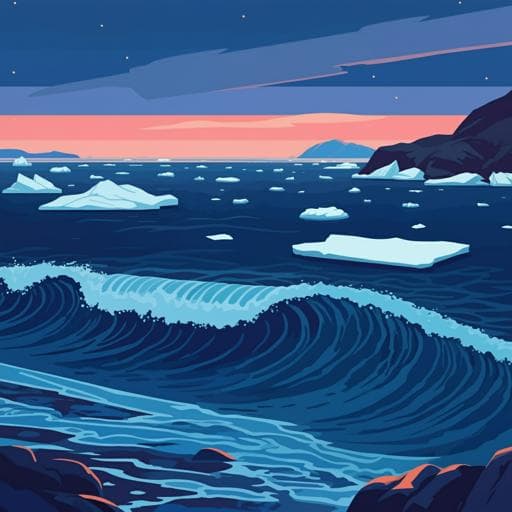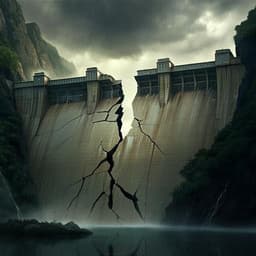
Earth Sciences
Increasing coastal exposure to extreme wave events in the Alaskan Arctic as the open water season expands
M. Henke, T. Miesse, et al.
This research by Martin Henke, Tyler Miesse, André de Souza de Lima, Celso M. Ferreira, and Thomas M. Ravens explores how declining Arctic sea ice is amplifying coastal hazards in the Alaskan Arctic. Projections indicate a significant increase in coastal wave heights and an extended season of wave exposure to hazards, threatening the historical sea ice protection in the Beaufort coastal region.
~3 min • Beginner • English
Introduction
Arctic sea ice has declined markedly in recent decades, increasing open-water area and the potential for larger waves and enhanced coastal hazards in the Alaskan Arctic. Sea ice historically dissipates swells, limits fetch, and inhibits wind-wave generation; its retreat heightens wave energy and associated risks of erosion and flooding. The Alaskan Arctic’s most impactful coastal hazards are often tied to extratropical cyclones and strong wind events, historically occurring in fall when open water overlaps peak storminess. As the open-water season expands later into winter, shorelines are exposed to more frequent and potentially stronger storms that are trending poleward and may intensify in winter. Prior work shows timing of extreme waves shifting later in the year and projects ongoing sea ice loss and lengthening of open-water periods, yet there remains uncertainty about how future seasonal ice decline will modify exposure to storm-induced coastal wave hazards. This study aims to quantify how future sea-ice conditions influence coastal waves generated by a representative extratropical cyclone, using a high-resolution, region-specific wave and surge modeling framework to link sea ice extent to coastal wave response and project future seasonal exposure.
Literature Review
Multiple studies document increasing Arctic wave climate linked to sea ice retreat, with expectations of ice-free summers by mid-century and heightened coastal erosion and flood risk. Extreme coastal hazards in the Alaskan Arctic are associated with synoptic systems (extratropical and Arctic cyclones, strong wind events), with many impactful storms in autumn when open water persists. Projections indicate increased winter storminess and northward-shifting storm tracks. Prior research has inferred wave height increases from open-water expansion, hindcast later-season extremes along the Beaufort coast, and examined sea ice–wave interactions, but robust numerical simulations of coastal wave hazards using projected sea ice fields have been limited. Knowledge gaps include detailed spatiotemporal hazard characterization for different storm types and the role of landfast ice in modulating exposure, especially outside the spring–early summer season.
Methodology
Sea ice analysis: A CMIP6 multi-model ensemble (MME) was constructed for SSP2-4.5 and SSP5-8.5 to assess 2050 (2050–2059) and 2070 (2070–2079) decades. Monthly sea ice extent (SIE; area with concentration >15%) was computed pan-Arctic and regionally (combined Chukchi and Beaufort Seas per NSIDC masks). Historic SIE came from the NSIDC Sea Ice Index. Even weighting among models used model-mean realizations prior to inter-model averaging. CESM2-WACCM was selected to provide daily sea ice concentration fields for the storm simulations, sampling mid-decade years (2055, 2075) with multiple ensemble members per scenario.
Storm and wave modeling: The coupled ADCIRC+SWAN model simulated astronomical tides, storm surge, and waves with forcing from ERA5 hourly 10 m winds and mean sea level pressure. Sea-ice effects on surge used ADCIRC parameterization (Joyce et al.), capturing amplification under partial coverage and suppression under high coverage. Wave attenuation in ice used SWAN’s IC4M2 parameterization with coefficients from Meylan et al. The model domain covered Alaska with resolution sufficient for coastal processes. Simulations spanned December 20–January 9 for a representative extratropical cyclone that impacted Alaska on December 31, 2016, tracking from the North Pacific through the Bering Strait to the Chukchi Sea.
Simulation ensemble: 23 total simulations included (i) a baseline (historical) run using ERA5 sea ice; (ii) future runs using CESM2-WACCM daily sea ice for each ensemble member of SSP2-4.5 and SSP5-8.5 in 2055 and 2075; (iii) idealized bounds with fully ice-free and fully ice-covered Chukchi–Beaufort regions. For future scenarios, multiple realizations were averaged to account for internal variability, yielding mean sea ice and maximum significant wave height (Hs,max) fields.
Validation: Model skill was evaluated against ESA Remote Sensing Significant Wave Height L3 product (Dec 25, 2016–Jan 5, 2017), showing correlation 0.97 and mean bias −0.42 m. Additional nearshore validation (Aug 2019) against multiple buoys showed mean bias <10 cm and correlations >0.85.
Coastal sampling and exposure analysis: Nearshore wave heights were sampled along 106 Arctic Coastal Dynamics (ACD) shoreline segments for the US Chukchi/Bering and Beaufort coasts. To focus on impactful conditions absent sea ice, only mesh nodes exceeding 0.5 m Hs,max in an ice-free simulation were included for segment medians. Median coastal Hs,max per region was related to average simulation SIE via logistic-type curve fits to identify protection (high SIE) and saturation (low SIE) thresholds. Using these fitted relationships with MME monthly SIE projections, seasonal curves of median coastal Hs,max were derived to estimate future seasonal exposure windows.
Key Findings
- Pan-Arctic September SIE reductions relative to historical: SSP2-4.5 2050: −71%; SSP2-4.5 2070: −93%; SSP5-8.5 2050: −95%; SSP5-8.5 2070: −100%, implying effectively ice-free conditions under most future cases.
- Regional (Chukchi+Beaufort) SIE shows delayed attainment of maximum coverage (historically before December); future medians do not reach full regional coverage until at least January, and SSP5-8.5 2070 never reaches full coverage.
- All future simulations expand open water north of the Bering Strait and increase Hs,max. Under SSP5-8.5 2070, the Chukchi and Beaufort are nearly ice-free during the storm window; Hs,max increases exceed 4 m across much of the Arctic region and along northern Alaska, with particularly large growth off northwest Alaska.
- Coastal Chukchi segments: Baseline median Hs,max mostly <0.5 m; future scenarios yield widespread increases, with median Hs,max commonly >1 m and up to 2–3 m near Point Hope; SSP5-8.5 2070 shows the strongest response with nearly all segments >1 m.
- Coastal Beaufort segments: Only SSP5-8.5 2070 produces substantial activity (barrier islands 1–2 m; inland segments <1 m), contrasting near-total suppression in baseline and other futures.
- Relationship between coastal waves and SIE: Chukchi coast median Hs,max ≈0.25 m at maximal SIE (≈1.75×10^6 km²) indicating protection threshold; as SIE decreases, Hs,max rapidly grows and saturates near ≈1.5 m by SIE ≈1.25×10^6 km², indicating high sensitivity to initial SIE reductions but limited response beyond saturation. Beaufort coast shows more gradual response, with saturation only as the region becomes nearly ice-free, implying potential for further growth with additional sea ice loss outside the immediate region.
- Seasonal exposure projections (median coastal Hs,max using MME SIE): For the Chukchi coast, maximum protection historically by December shifts to January under SSP2-4.5 2050/2070 and SSP5-8.5 2050 (≈+1 month exposure). Under SSP5-8.5 2070, the protection threshold is not reached by March (≈+3 months exposure, with winterlong exposure). For the Beaufort coast, maximum protection shifts from November to past December (expanded exposure), and fall wave magnitudes increase: future median September Hs,max ≈1.2 m versus historical ≈0.5 m; saturation limit is reached in September (and up to November for SSP5-8.5 2070).
- Overall, all futures show increased coastal wave heights and extended seasonal exposure windows; differences between pathways are small by 2050 but diverge strongly by 2070, with SSP5-8.5 yielding much greater risk.
Discussion
The simulations demonstrate that declining seasonal sea ice extends the window during which coastal Alaskan shorelines are exposed to storm-driven waves and increases wave magnitudes during that window. By 2050, both SSP2-4.5 and SSP5-8.5 produce similar extensions of exposure; by 2070, SSP5-8.5 leads to markedly greater sea ice loss and a much longer exposure season, with the Chukchi region failing to reach full protection during winter months. The Chukchi coast exhibits a saturation behavior: relatively small initial reductions in regional SIE drive rapid increases in coastal wave heights up to a limit beyond which further sea ice loss imparts little additional increase for this event. This indicates that other limiting factors (storm track, wind fields, coastal bathymetry, and dissipation) can cap coastal wave response, challenging simplistic fetch-based assumptions. In contrast, the Beaufort coast’s coastal wave response grows more gradually and reaches saturation only under nearly ice-free conditions, implying that future ice losses can substantially increase fall wave magnitudes. The shift of exposure into winter—which may feature more intense and poleward-shifted extratropical cyclones—suggests heightened future hazard frequency and severity. The study’s approach provides an event-based linkage between regional SIE and coastal wave response, enabling seasonal exposure projections but also highlighting uncertainties related to storm climatology and landfast ice presence.
Conclusion
This work couples high-resolution ADCIRC+SWAN modeling with CMIP6 sea ice projections to quantify how future seasonal sea ice decline will alter coastal wave hazards from a representative extratropical cyclone in the Alaskan Arctic. The study establishes functional relationships between regional SIE and coastal Hs,max for the Chukchi and Beaufort coasts and uses them with ensemble SIE projections to estimate seasonal exposure windows. Key contributions include demonstrating consistent increases in coastal wave heights across future scenarios, identification of protection and saturation thresholds, and projection of extended exposure by about one month by 2050 and up to three months by 2070 (SSP5-8.5) for the Chukchi, with substantial fall wave increases in the Beaufort. These findings indicate elevated future risks to Arctic communities and critical infrastructure if high-emissions pathways persist. Future research should extend to multi-event ensembles with varying tracks and intensities, incorporate projected changes in storm climatology, and explicitly model landfast ice formation and breakup to refine exposure estimates.
Limitations
- Results are based on a single extratropical cyclone event; different storms (tracks, intensities, seasons) could yield different Hs,max magnitudes and saturation thresholds.
- Landfast sea ice was not explicitly projected; its uncertain timing and persistence introduce uncertainty in coastal protection, particularly outside autumn–early winter.
- Sea ice fields were averaged across time and ensemble members for visualization, potentially creating marginal ice artifacts; model bias (e.g., −0.42 m mean wave height bias) may persist across simulations.
- Future cyclone activity and storminess trends remain uncertain; changes in storm climatology could alter future hazard seasonality and magnitude beyond what is assumed by using a historical storm.
- The derived SIE–wave response relationships are event- and region-specific and may not generalize to all coastal segments or storm types without further validation.
Related Publications
Explore these studies to deepen your understanding of the subject.







